Organization
of the Fire Service Fire
department units are usually divided into
a few basic categories.
Company- This
is the basic unit. This is made up of a single piece
of apparatus and it’s crew. The company can
be supervised by an officer. This is usually a Captain
or Lieutenant. This is not always the case. Sometimes
there is not an officer on the apparatus. A common
example of this would be an MICU. MICU’s are
often staffed with two drivers or a driver and a
firefighter. (Note: Some departments are considering
having lieutenants on MICU’s.)
If the Station Captain
is off duty for some reason, (vacation, illness etc.)
the Lieutenant will often move up and take his place.
He would be referred to as an “Acting Captain” for
the day. In some cases, a non-officer, such as a
driver would move up to “Acting Lt.” if
that officer is either off or working in another
capacity.
Battalion- This
is usually made up of about 5 stations and the companies
that are quartered there. But this is one of those
things that vary greatly from city to city. This
unit of vehicles and personnel is usually supervised
by a Battalion Chief. Some smaller cities will have
only one “Bat Chief” on duty over the
entire city. He will serve as the only chief officer
on duty on nights and weekends. Some cities assign
this rank to chiefs over a particular section. For
example a Battalion chief may be in charge of training
or communications. This has many variations and definitions
depending upon the city.
Districts
(Or District Chiefs)- This is another
division that is most often employed only in the
larger departments. A district chief is usually
over several battalions. An exception to this does
occur. Some cities will choose to not have “Battalion
Chiefs” but will have a “District Chief” on
duty. In Canada (or Houston) the term "District
Chief" is applied to someone over several
companies
As
you can see the application of the term “Chief” can
be a little vague. Each city can be slightly different it comes to how it divides
up it’s resources for supervisor control.
You
might want to think of it this way.
- Firefighter - (FF) -Basic worker. Usually 1 -3 in most
companies. (Note: "Firefighter" is
the generic term for all members of
a fire department, but it is
also a rank within the organization.)
- Driver -
Also known as “Engineer”, “Chauffeur”, “Fire
Equipment Operator” (FEO) and other terms.
In most departments this is the person who drives
the vehicle and operates the pump or aerial. He
is a specialist who knows everything about that
piece of apparatus. Note: In some northern cities
the driver and the pump operator / engineer may
be two different people. Note: Some departments
might have a rank of "Second Driver" or "Sub-Driver".
This is a person designated to drive when the regular
driver is off for some reason. Departments without
this rank will usually pay a firefighter driver
pay or "out-of class" for the
day.
- Lieutenant -
(Lt.) - This is usually the officer over a single
company. Depending upon the city he may be on an
engine, truck, rescue company or whatever. There
might be more than one assigned to a station. Some
cities will not have lieutenants but will go from
driver to captain in their rank structure.
- Captain -
(Capt.) - This officer commands a single company
but also is the ranking officer at a station that
may have several companies. He may have one or
more lieutenants working at the station with him.
This officer is often the initial command at emergencies
and can be called upon to fill in for the Battalion
Chief during his or her absence. A captain may
also be over a special section or function. Examples
are: Dispatch, Training, EMS etc.
- Senior
Captain -
This is a somewhat rare rank designation.
Some departments may have no Lieutenants,
but instead have the ranks of "Captain" and "Senior
Captain".
- Battalion
Chief - (BC) - Operational supervisor
over several companies. Often the highest ranking
officer on duty on a 24 hours basis. (An exception
to this occurs in the very large cities.) Can
also be over a division of the department such
as Training, Communications, etc. NOTE: In North Bay Ontario, and some other departments, this position is referred to as "Platoon Chief"
More
about Battalion Chiefs.
- District
Chief - Operational supervisor over
several battalions. Depending upon the city,
this person could also be over a special group
such as Training or Communications. This person
could be the same as a Battalion Chief but just
a different name. (For example, Houston FD has
the Ranks of: FF, Driver/Engineer, Captain, Senior
Captain, District Chief, etc.)
- Deputy
or Assistant Chief - In some departments
this may be the same as a battalion chief. In
other departments this is a staff chief.
Please
note: It is not uncommon at all for departments to
simply not have lieutenants or to not have captains
etc. A person may go directly to captain from driver
or from lieutenant to battalion chief if a rank
in between, does not exist in that department. They
can also have sergeants or majors, depending upon
the tradition of that departments. Oklahoma City
FD might be a good example of a department with sergeants
and majors. One might guess that this is designed
to have a pay scale, or rank structure, that mirrors
the police department.
Fire
Department Rank Insignia
Some
terminology and the rank structure in the fire
service is generally accepted as something that
came from the Civil War. Prior to the Civil War,
U. S. fire departments were often run something
like a business. Many early fire brigades were
private organizations who were paid by insurance
companies. There were chiefs, bosses, leaders
and foremen and such. During the Civil War
entire fire
departments joined up as a unit. They became
units like Infantry “Companies” etc.
(FYI- Many of the elite Zouave brigades were
made up of
fire brigades.)
The leaders were given rank and that rank or
title survived the war. After the war some men
were known
as “Captain” for the rest of their
lives and when they were replaced, the department
got a new “Captain” for that company.
There were also other influences on the rank
structure of fire departments. Credit for the
first "professional" fire
brigade is given to Napoleon Bonaparte. As French
emperor, he ordered that a division of the French
army known as Sapeurs-Pompiers be used to protect
Paris with 30 powerful manual fire pumps by 1800.
We can presume that this organization had ranks.
In fact, many military words, such as those for
rank, come directly from Old French. (i.e."Lieutenant" & "Captain")
The very first, recorded, full time, fire brigade
was in first or second century Rome. This consisted
of approximately 7000 "Vigiles". The
rank insignia for the fire service is a combination
of traditional fire service icons and the common
military symbol for such a rank. For many ranks
you might see either insignia or both. A captain
may have one type on his collar and another on
his hat or helmet.
In
the early days, of North American fire departments,
orders were given to the troops, by officers, through
the use of a large brass device that resembles
a megaphone. These were very ornate brass horns.
They were commonly called “bugles” or
speaking trumpets.

The
person with the bugle hanging from his neck or
shoulder was easily identified as the person in
charge. Officers became identified with these objects
so a small pin in the shape of a bugle became a
type of rank insignia for officers. The more “bugles
on his collar” the higher the rank. An expression
still used today. 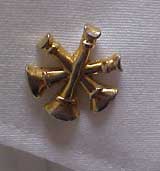
3 bugles collar brass.
Note: It is probably OK that we traditionally refer to fire department rank insignia as a bugle, even though they are not really musical instruments. Some people object to the term "bugle" because it is not a brass musical instrument, and never was. Let's face it, this is the way people name things. We latch onto something the item resembles or was derived from historically. This best example might be the fire "plug". It is not a plug. It is a hydrant. What many fire departments call a PTO has long been replaced by a transfer case. A fire engine and its crew is traditionally a "company" not a unit! Jackrabbits are not rabbits at all, they are hares. The Belgian Hare, a popular pet, is a rabbit. (Who stores gloves in a "glove compartment"?) There are hundreds (perhaps thousands) of other examples of common inaccurate names being derived from historical, fictional or erroneous perceptions. Yet we don't seem to worry about them. It is the nature of a living language. (BTW, "Bugles" are also a tasty corn chip and a glass bead sewn into clothing.)
Many
departments have adopted a less formal or less military style
of uniform. This may be because of some new national
standards on what clothing used for firefighting
can be made from. Even "golf" style shirts
or t-shirts that have been constructed and approved
for firefighting, are relatively expensive. This
may change as more uniform manufactures learn how
to comply with these standards at lower costs,
or budgets recover. Many departments have formal
dress uniforms for ceremonies and staff officers
will usually wear uniforms that have a more formal
appearance. But because of recent budget crunches,
some departments have suspended the purchasing
of new dress uniforms. Some departments have the
rank spelled out on some uniforms. Others have
sewn in rank insignia while others still use pin
on brass. The number of variations are endless.
Firefighter-
No particular insignia. But this person may have
collar brass that says something. For example: “SLFD”
Driver
- May have no insignia or may have a
simple Maltese Cross or something that looks
like a steering wheel. They may also have simple “FD” or “FEO” or "Driver" collar
brass.
Lieutenant -
 or or 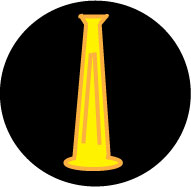
May have a single bar as in the military or may have a single “bugle” or
both. The bar can be gold or silver. Bugle rank insignia can be mounted on
a disk or can be just the bugles by themselves.
Captain -
 or or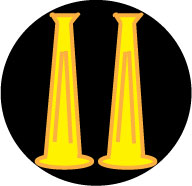 
May have two bars, just like the US military or may have two vertical bugles.
Sometimes, by mistake, you may see a captain wearing two crossed bugles.
The bars are often gold but can be silver in appearance.
NOTE:
While rare, it is possible to see ranks
like "Sergeant" or "Major" in
a fire department. Often this is the result of
a PSO type of function where
some members are also police officers, but it can
be seen in departments that are strictly fire and
rescue.
Battalion
Chief - 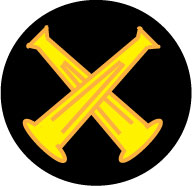 OR OR 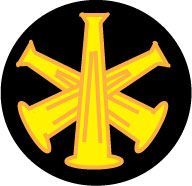 OR OR  OR OR  OR OR
This officer may be denoted by:
Two Crossed Bugles - The traditional symbol. OR
Three to Four Crossed Bugles depending upon his or her distance from the
chief. OR
One gold oak leaf (like a major in the military) OR
One Star (Again this depends upon the distance from the chief of the department.
He could have as many as three stars.)
District Chiefs -
 Or
any combination of the above. Or
any combination of the above.
These ranks usually only exist in the larger departments. Their rank insignia
could be any combination of the above stars and bugles or can even be an
eagle like a colonel’s rank insignia. Note: Some departments
may refer to their on duty chief(s) as District, Deputy, or Assistant Chiefs.
This person might even be called, "The Shift Commander" or "Platoon Chief".
Assistant
or Deputy Chiefs-
Most often these officers will be wearing bugles or stars. These will likely
be wearing three or more of whatever it is. It
should be noted that in some departments, bugles
are what lower chiefs wear and stars are reserved
just for the top level assistant chiefs. (Or
the other way around.)
Chief of the Department -
    
Chiefs often wear either FIVE STARS
or FIVE BUGLES or both.
In order to be able to do this his lower chiefs must have some insignia that
suggests it. If none of the people under him are wearing more than one star
it might not be appropriate for him to have five. Departments try to divide
up the stars and bugles so it makes sense. This is why battalion chiefs have
such a huge variation in rank insignia. Sometimes a battalion chief is the
second highest rank in the department. Sometimes it is the sixth highest
rank. The number of bugles or stars often depends upon how far you are from
the chief.

1970-
early 1980's Firefighter Helmet
A
Note About Helmet Color
While
on the subject of uniforms we should mention
that there is no "set in stone" standard
for the color of helmets or what rank each color represents. Until the 1980's
it was common for all firefighters to have
black helmets. Only chiefs had a different
color and that was white. Officers would have
an emblem, or stripe, on their black helmets.
New helmet design gives us a choice of colors.
Captains often have red helmets and Chiefs
are usually white. A national consensus is
emerging but some departments apparently are
clinging to their own traditions. Some departments
will have a color for lieutenants while others
do not. You may find that EMS personnel have
a specific color of helmet in some communities
while in others they simply reflect the rank.
In the western part of the U. S., officers
will have red or white helmets while firefighters
(the rank) will have yellow. As you go east
you will find black as the more common color
for firefighters. LA has yellow helmets. NY
has black. Dallas has yellow for non-officers
while Houston uses black for firefighters.
Luckily you will often find a written out rank
position or "bugles" on the helmet to give you
a clue.
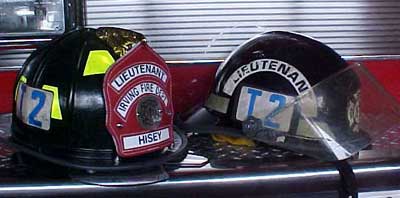
Two Lt's helmets from the same
department.
(But in some departments black would signify the rank of firefighter.
In other departments every helmet is black.)
You
may also find different styles of helmets within
the same department. This may mean nothing. A department
may decide to go to a different style of helmet
as replacements are needed. Some departments allow
members to purchase their own helmets. Even personally
owned gear must comply with NFPA Standards. Here
is a great page showing gear and helmet color coding
(for that department.)
http://www.sccfd.org/clothing_turnouts.html
Here
is another:
http://www.cityofmaryesther.com/FireDepartment/Lore/FireServiceTrivia.html
Fire
Investigation / The Fire Marshal's Office Arson
Investigation
There
are probably as many ways to set up an arson investigation
division are there are opinions on what color fire
apparatus should be. Some
fire departments will have investigations as one
of the things it does. A person can be assigned,
or request transfer, to the branch that conducts
investigations. You can be an officer at a station
one day and an investigator the next. You may stay
in that position for any number of time intervals.
In some departments, it may be a position that
is rotated after a period of years. In others,
once you are in that position, you are expected
to remain there for an extended period of time. You
will also find fire departments who have turned
over arson investigations to another agency. Fire
investigators are USUALLY also police officers.
That is to say they can investigate the CRIME of
arson and arrest suspects. You will often see fire
investigators carrying fire arms. Most communities
have recognized that this is an important certification
for the fire investigator. But there are exceptions.
In many states you do not have to be a peace officer
in order to be a certified investigator. In some
situations or jurisdictions the investigator conducts
the investigation of the crime and then gets the
police to arrest the suspect.
Other
Fire Marshal's Responsibilities A
few departments will have a completely separate
division that is prevention, inspection, and investigation.
When you hire on to the fire department you choose
where you want to work by the application you submit
and the test you take. If you are hired to be in
firefighting and rescue, that is where you will
be. If you are hired to be in prevention / investigation,
you will never be fighting a fire. This is often
called the “Fire Marshal’s Office” although
it can be, and often is, known by other descriptive
names. The
Fire Marshal’s office is usually charged
with the following responsibilities:
- Building
inspections.
- New
construction plans approval.
- Public
Education
- Arson
investigation
The
Fire Chief and the Fire Marshal and the Fire Commissioner
are usually very separate offices. The fire chief
is usually under the fire commissioner. The fire
marshal is usually under the fire chief. You would not have to
look too hard to find exceptions to this. In a
few communities the fire marshal may be the only
paid person on the department. Everyone else, including
the chief, are volunteers. In these communities
the fire marshal conducts the investigations and,
at least to some degree, oversees the firefighting
and rescue operations. It is probably more common
to not have a fire commissioner than it is to have
one. The office of fire commissioner is usually
only found in a few very large departments. This
might be an appointed or elected position.
Please contact for permission to reproduce anything on these pages.
Most
Action or Apparatus Photos Copyright© Ben
Saladino.
Most photos since November 2002 taken with Nikon Coolpix 5700.
See hundreds more at: http://www.bensware.com/firetrucks/photos.htm
Back
To Contents |